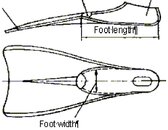"Life is just a series of approximations!" The perfect test of fins doesn't exist, but we've at least gotten some good, relatively-objective information.
I myself have now tested over 70 different brands/models of fins over the past several years, partly independently and also for a few years as a member of the original Scuba Lab fin-testing team. I did my testing with UW speedometers for speed and also did efficiency, static thrust, and ergonomic tests of the fins. I think I have been minimally biased because I only wanted to find out what worked best for my own diving and I didn't care which fins that happened to be. I was not paid by any company or advertiser and had no vested interests in any of them.
I posted UW photos of some of my gear testing techniques, including the UW speedometer with air-integrated computer (Suunto Cobra) and stopwatch, with a report on tests I ran of the Halcyon backplate/wings, but that report is currently down with scubadiving.com's archives, which are dead. I might re-post it later, but don't have time at the moment.
The most recent (but now old) central gateway to my independent tests is at:
Fins -- Main Page
(Unfortunately, several of the links in that old report are broken because some of the particular reports were posted on scubadiving.com and their archives are dead, as indicated above. I hope to eventually re-post the ones from scubadiving.com on a different server, but have not gotten around to it yet.)
My latest fin-testing report, for the ScubaPro Seawing Novas, Twin Jet Max, and Aqua Lung SlingShots is at:
My tests of 3 recent ScubaPro and AquaLung fins
I'll add just a few bottom-line comments here:
It is difficult to generalize about categories of fins, such as "paddle" vs "split" because there is so much variability among different kinds within each category, particularly depending on the materials that the fins are made of. Fins "out of the same mold" can vary because of different materials or even different batches of the same material!
Regular Jets in particular are a good case in point. I have tested several pairs of Jets through the years. I got highly variable results depending on the particular pair being tested, which in turn appeared to vary with the batch of rubber that they were made with (the regular Jets have been made over a long period, in different manufacturing locations including both US and Mexico, and with many different batches of rubber). Jets also seem to depend on size, with the XL being better, and smaller ones, such as M, being too stiff. Depending on the variability in materials and size, some of the Jets I've tested have been among the best fins I've ever tested and some were among the worst, with most being somewhere in between.
ScubaPro's Twin Jets provide another excellent example of the different performances resulting from different materials. Despite being identical in form and shape, the
black Twin Jets are great fins whereas the gray and other-colored (yellow, etc.) are awful because they are too soft.
The only relatively-consistent finding is that full-foot fins in general are better than open-heel fins, but full-foot fins are limited to use where you don't need to wear boots, such as in boat diving in warm water.
In my personal opinion:
The three top open-heel fins for general scuba diving purposes are the Apollo bio-fin pro, ScubaPro Seawing Nova (although they can be slippery on boats and decks), and ScubaPro Twin Jet (but
only in the black version and definitely NOT the Twin Jet Max [see the link above]).
For technical diving I recommend the good old regular Jets (if you can find one of the good pairs ... it's a crap shoot) or a good clone such as the OMS Slipstream. Note: some of the clones, such as the Aqualung Rockets have NOT tested good for me.
For full-foot fins, there are many good ones and only a few that I would not recommend (such as the full-foot Twin Jet colored ones [gray, yellow, etc.] which are too soft). The main issue in full-foot fins is fit -- be sure to try them on your feet before buying. A proper full-foot fit is snug but not too tight and definitely not too loose. I wear full-foot fins a lot when on boats in warm water. I myself wear a pair of socks (such as low-cut sports socks) for comfort and to prevent chaffing of the skin.
DSAO -- with good fins
Jim Grier





